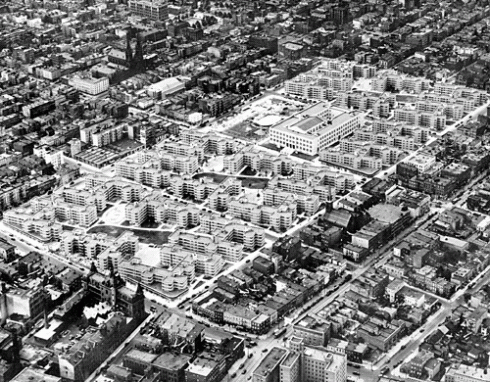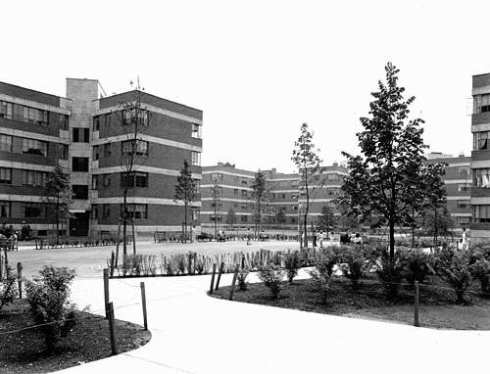There’s more I want to say about public housing. Well actually, what I really want to do is to go through all the NYCHA developments in chronological order – but then, I want to do a lot of things. I guess I’ll just add it to the list of all the other lists I want to get around to someday: skyscrapers, churches, oldest buildings in New York, tangents related to President John Tyler (and yes, I have some really wild weekends).
But in thinking about whether public housing is a failure or not – or maybe I mean to say in rethinking the idea that public housing is implicitly a failure – I keep thinking how desperately private developers in gentrifying neighborhoods must want to get rid of them. They’re impossible to gentrify! (Well maybe not impossible – the whole nefarious practice of selling open NYCHA land to private developers is a step in that direction, though one for the time being that’s perhaps been halted). But still, when public housing is torn down – as it has been in numerous American cities besides New York – it’s almost never replaced by brand new 100% affordable housing. Of course not! 100% affordable housing is terrible for people who want to make a lot of money….and kind of hand in hand with that, who hate “excessive” government involvement. It sets a really bad precedent – a precedent that these people have been trying to kill for a long time (and quite successfully). In these public housing replacements there’s always a mix – and often a majority mix – of market rate buildings and apartments. There’s almost always a loss in the net total of affordable units. Well of course again! That’s the whole point of getting rid of public housing.
So give New York its credit: it wasn’t just the first builder of public housing, it’s also been good about not tearing its public housing down. Hell, some of it is landmarked even – including First Houses that we talked about last time. Another one is the Williamsburg Houses – made up of 20 four-story buildings covering 12 city blocks between Maujer and Scholes Street and Leonard Street and Bushwick Avenue. Williamsburg Houses were begun in 1936 – just one year after the first tenants moved into First Houses – and opened in 1938, making them some of the earliest public housing projects in New York. Unlike First Houses however, Williamsburg Houses weren’t built by the New York City Housing Authority (NYCHA) alone, but instead were a collaboration with the Housing Division of the Public Works Administration (PWA). It wasn’t until 1957, almost 20 years after opening, that the project was turned over to NYCHA’s full jurisdiction and ownership.
It’s worth noting this distinction for a moment, because it points in part towards why public housing really isn’t built anymore. The PWA – the builder of Williamsburg Houses – was a federal program; this was federal money building affordable housing. What made the PWA especially unique is that it wasn’t just federal money (ie. financing) but actual direct involvement of the federal government in the planning and construction of public housing. This was something new entirely. Prior to the PWA the first federal agency to involve itself with housing was the Reconstruction Finance Corporation (RFC). The RFC was created in 1932 to (among many other things) provide low-interest loans to limited-dividend housing corporations. It only made 2 such loans though during the first two years of its existence. So when the PWA, and its housing division especially, with its more robust involvement, came along in 1933 (as part of FDR’s New Deal – and originally called the Federal Emergency Administration of Public Works, until 1935) it represented a pretty big change. In the scheme of things its housing program was actually pretty short-lived, but in a 3 and half year period (starting in 1933) it collaborated on the construction of some 51 projects in 36 cities (though as its critics (it’s critics on the left I mean) would point out, that apparently only created some 29,000 units). The Housing Act of 1937 (aka the Wagner-Steagall Bill), while strengthening the federal government’s commitment to housing, began to shift greater control to local authorities – returning the government’s role to essentially that of financing.
Maybe it was PWA’s influence, or maybe it was just the excitement of the early days of NYCHA but when it came time to design the Williamsburg Houses it seems they went all in. NYCHA had a 5 person architectural board, including Richmond H. Shreve – a partner in Harmon, Lamb and Shreve of Empire State Building fame – and William Lescaze, considered one of the pioneers of modernism in American architecture. Shreve appointed Lescaze as the chief designer for the Williamsburg Houses. He opted for 4 “super” blocks, turned at 15 degree angles to the street grid – oriented to the sun and prevailing winds (prevailing winds?!) – and featuring a number of large and small courts that would flow into a large public space in the center of each block. The facades were light-colored, in tan brick and exposed concrete, with entrances marked by blue tiles and stainless steel canopies. The whole thing, though controversial at the time for its use of the “super” block, its breaking from the street grid, and its use of tan instead of red brick, was praised upon completion and has since been called by AIA, “the best public housing project ever built in New York.”
I don’t know – I don’t really see it, and I feel like most people would probably agree. But maybe that’s just because I’ve successfully internalized the fact that housing projects equal bad. I mean, these look like housing projects, ya know? (Though I have to say, they do look better in black in white – nostalgia?) But hey, 25,000 New Yorkers applied for the 1,622 available apartments when they first opened. That’s actually a much better ratio than the 58,832 New Yorkers who applied for the 105 “affordable” units in a new development on Manhattan Avenue in Greenpoint last year (which, of course is mainly composed of market-rate apartments – figure that those 105 “affordable” units make up 20% of the total). So who cares what Williamsburg Houses look like – these were 1,622 affordable units built all at once. That’s equal to 15 luxury developments that include 105 “affordable” units but otherwise drive up the rents everywhere around them every place they go up. And that are also also ugly. I mean personally, if I have to choose, I’ll take ugly affordable any day. Who’s with me?




My family was the first to move into these projects in 1938, when I was less than a year old, and I lived there for thirteen idyllic years on Stagg Walk. Nobody left until the early 50’s, when we transferred to middle income housing, built by the city. I grew up with the same friends (only two moved away before we did) and I went to P.S.49, and then Junior High school Gaynor, which was less than the length of a football field from our unit. The grounds were patrolled by housing police, and the grounds were wonderfully kept up by a large maintenance force. The insular nature of the courtyards for most of the units made for a fairly well protected experience growing up. My parents made friends with a number of people in our immediate area, and as I look back, I can see it was like a small town. Everybody knew everybody, and when I did something I shouldn’t have, somebody would see it, and immediately tell my mother. I could go on and on about how wonderful it was, especially situated in a very tough, congested slum, but like good sex, it has to have been experienced to understand how great it was. If they gave the care and attention to current housing developments like we got, it would be a whole different ball game.
I lived in the Williamsburg houses from 1938 to 1941 on maujer street but moved to vladeck houses on the lower east side in 1941